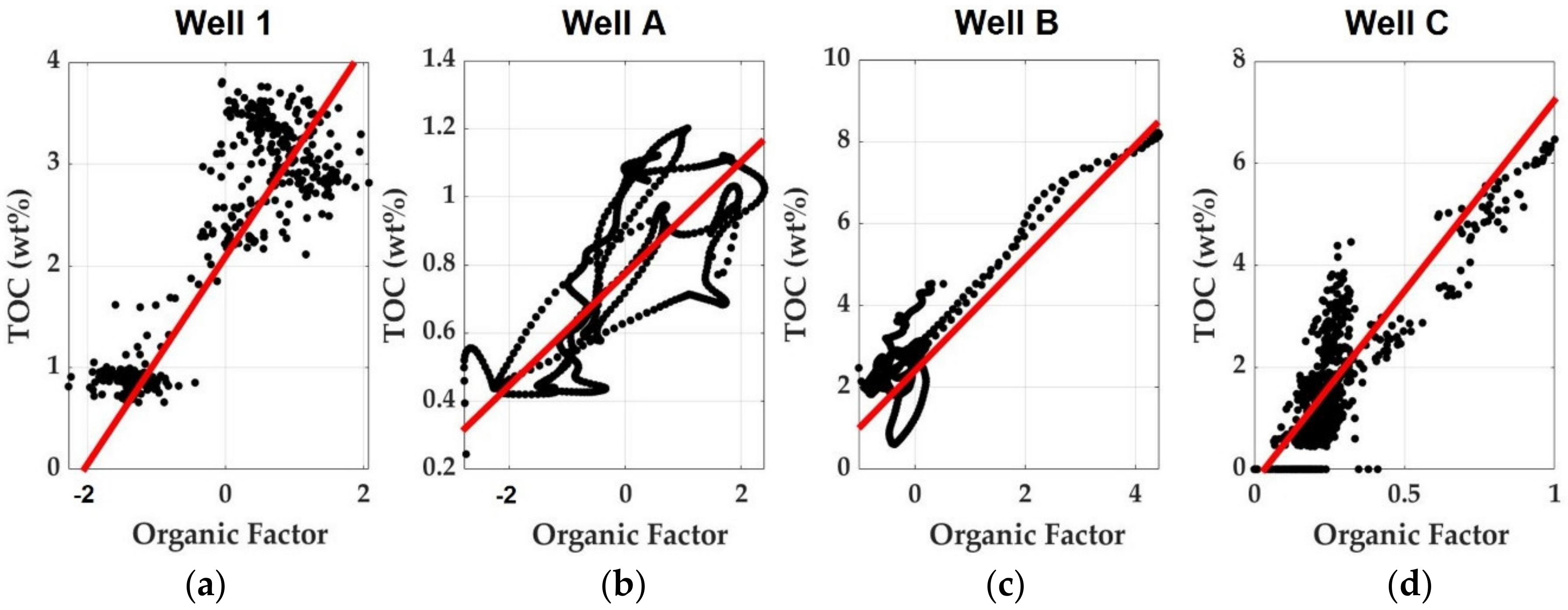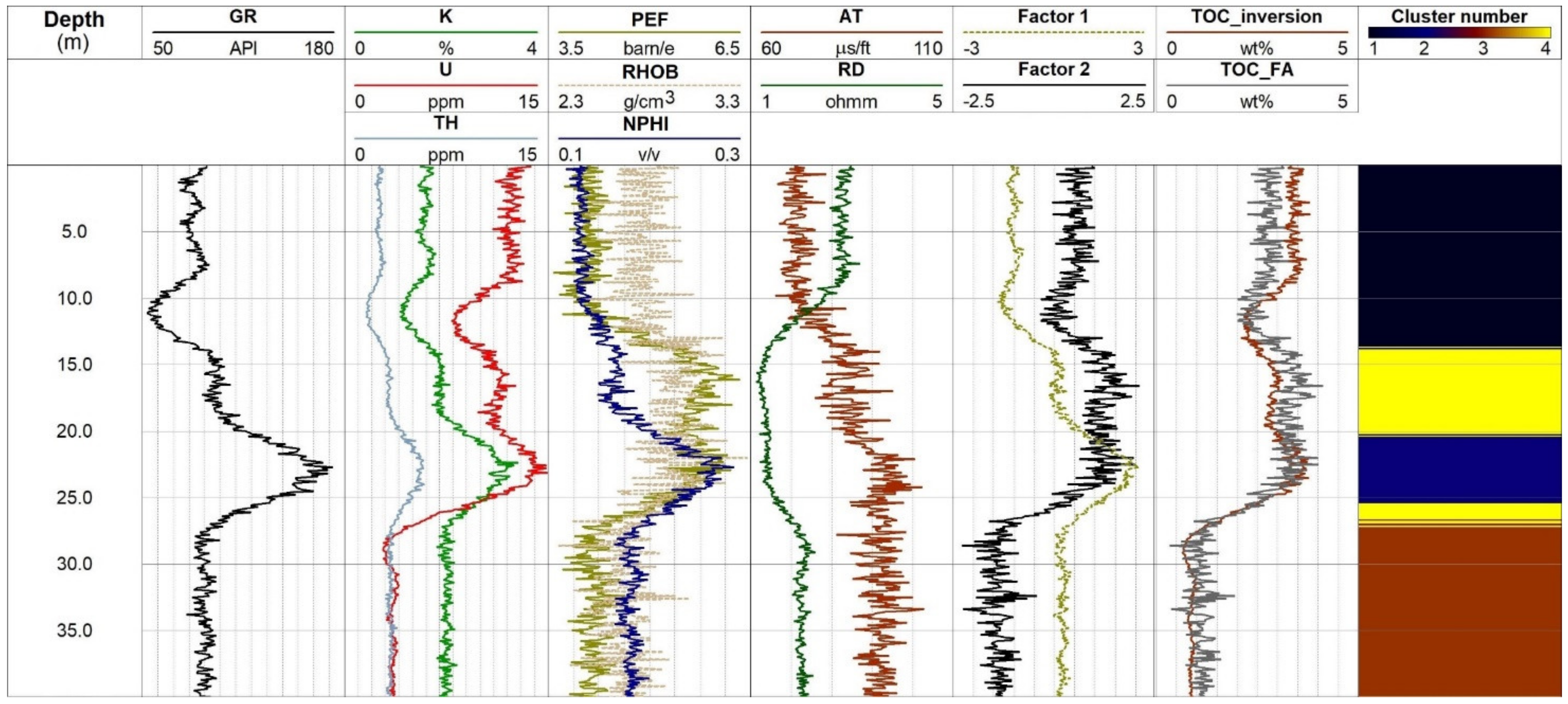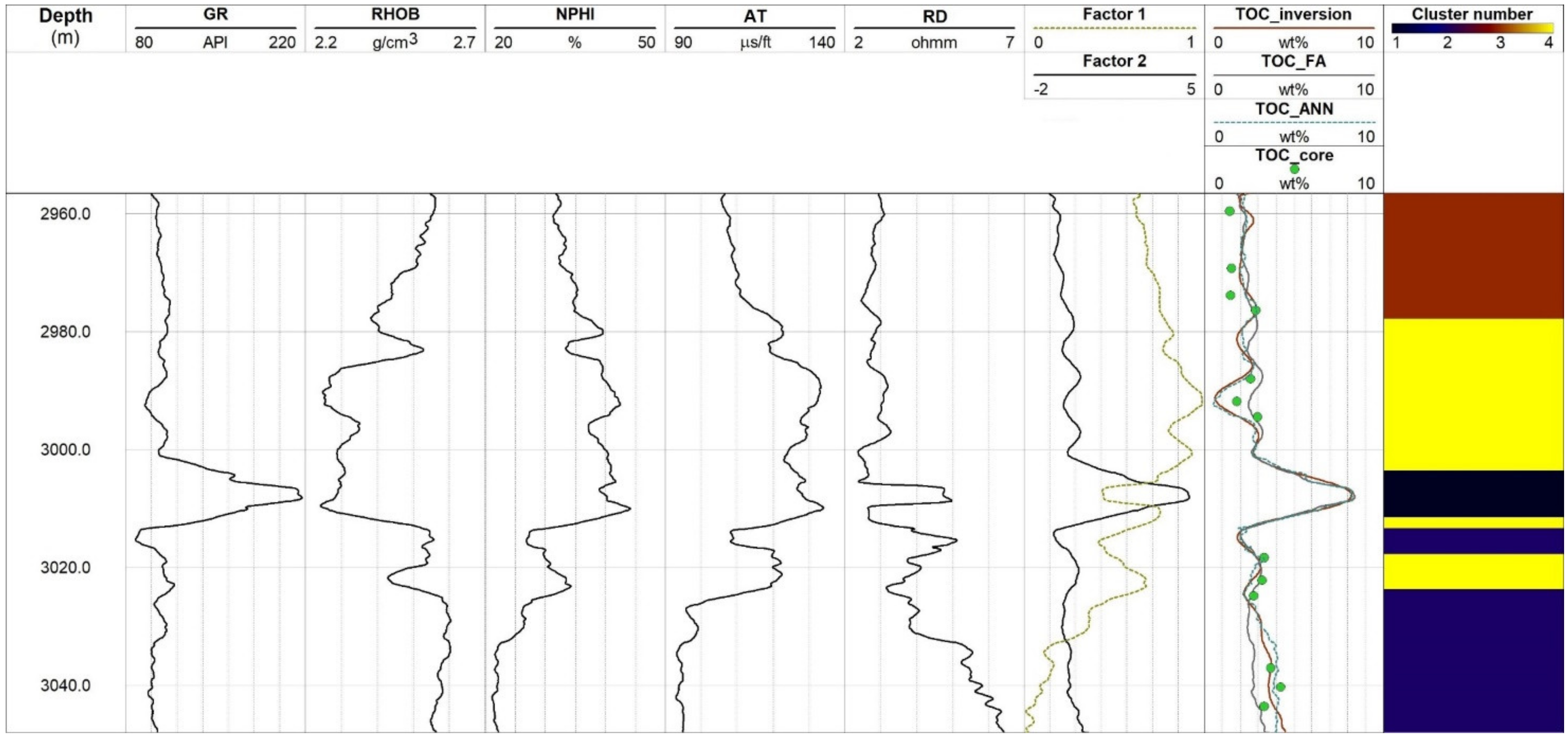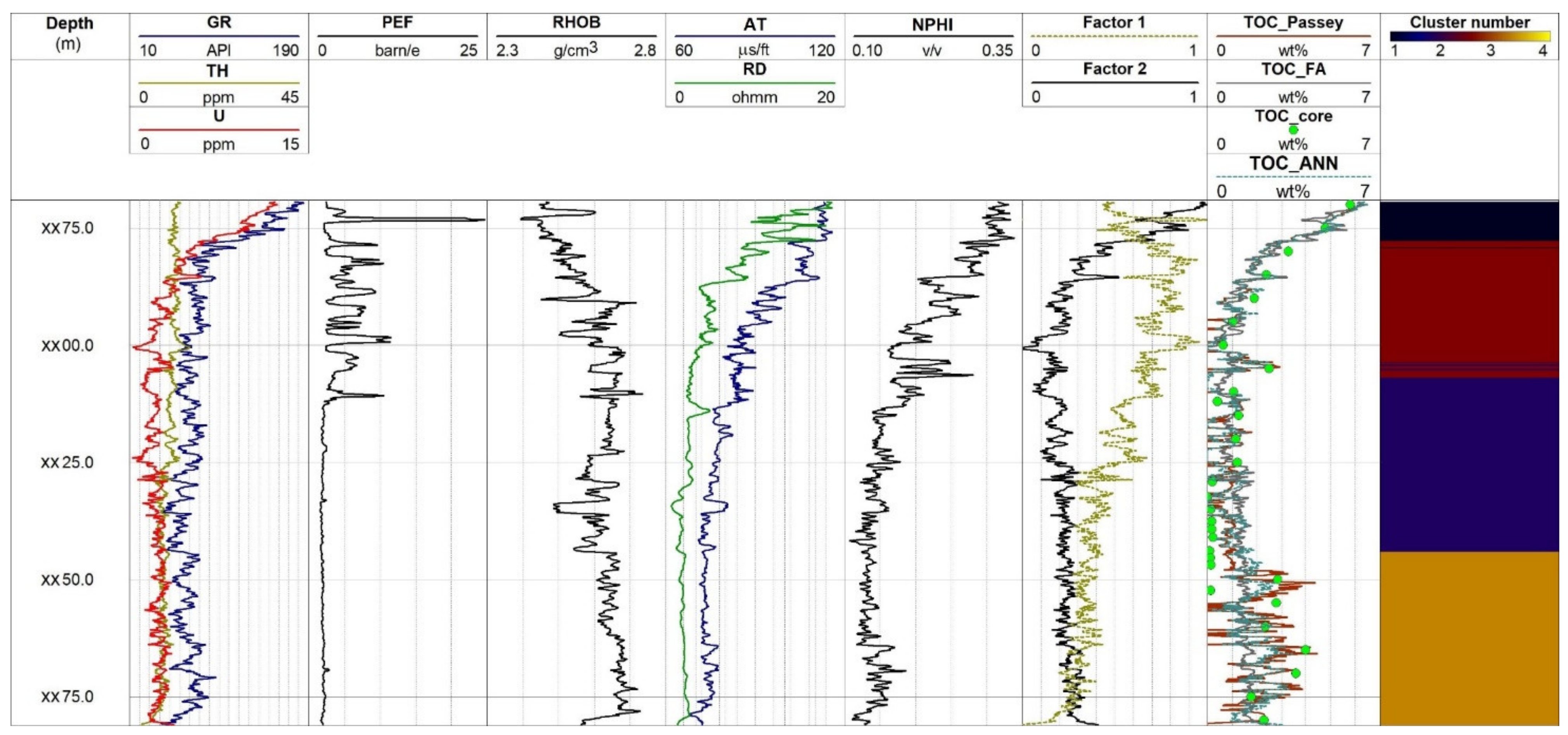Factor Analysis of Well Logs for Total Organic Carbon Estimation in Unconventional Reservoirs
Abstract
:1. Introduction
2. Materials and Methods
2.1. Geological Settings
2.1.1. Derecske Trough, Hungary
2.1.2. North Slope, Alaska, USA
2.1.3. North Sea, Norway
2.2. Traditional Determination of Organic Richness
2.3. Determination of TOC by Factor Analysis
2.4. Application of Interval Inversion
2.5. Application of Artificial Neural Networks
3. Results
3.1. TOC Estimation Results
3.1.1. Synthetic Modeling Experiments
3.1.2. Results in Well A
3.1.3. Results in Well B
3.1.4. Results in Well C
4. Discussion and Conclusions
Author Contributions
Funding
Institutional Review Board Statement
Informed Consent Statement
Data Availability Statement
Acknowledgments
Conflicts of Interest
References
- Zou, C. (Ed.) Unconventional Petroleum Geology, 2nd ed.; Elsevier: Amsterdam, Netherlands, 2017; Part 1, pp. 49–94. [Google Scholar]
- Bjørlykke, K. Unconventional hydrocarbons: Oil shales, heavy oil, tar sands, shale gas and gas hydrates. In Petroleum Geosciences; Springer: Berlin/Heidelberg, Germany, 2010; pp. 459–465. [Google Scholar] [CrossRef]
- Sun, S.Z.; Sun, Y.; Sun, C.; Liu, Z.; Dong, N. Methods of calculating total organic carbon from well logs and its application on rock’s properties analysis. Geoconvention Integr. 2013, 1–7. [Google Scholar]
- Passey, Q.; Kevin, B.; William, E.; Robert, K.; Somnath, S. From oil-prone source rock to gas-producing shale reservoir—Geologic and petrophysical characterization of unconventional shale gas reservoirs. Soc. Pet. Eng. 2010, 31350. [Google Scholar] [CrossRef]
- Valadez Vergara, R. Well-log based TOC estimation using linear approximation methods. Geosci. Eng. 2020, 8, 116–130. [Google Scholar]
- Lawley, D.N.; Maxwell, A.E. Factor analysis as a statistical method. J. R. Stat. Soc. Ser. D 1962, 12, 209–229. [Google Scholar] [CrossRef]
- Király, A.; Milota, K.; Magyar, I.; Kiss, K. Tight gas exploration in the Pannonian Basin. In Geological Society, London, Petroleum Geology Conference Series; Geological Society of London: London, UK, 2010; Volume 7, pp. 1125–1129. [Google Scholar] [CrossRef]
- Haás, J. (Ed.) Geology of Hungary; Springer: Berlin/Heidelberg, Germany, 2013. [Google Scholar]
- Houseknecht, D.W.; Bird, K.J. Sequence stratigraphy of the Kingak shale (Jurassic–Lower cretaceous), national petroleum reserve in Alaska. AAPG Bull. 2004, 88, 279–302. [Google Scholar] [CrossRef]
- Rouse, W.A.; Houseknecht, D.W. Modified method for estimating petroleum source-rock potential using wireline logs, with application to the Kingak Shale, Alaska North Slope, vols. 2016–5001. In U.S. Geological Survey Scientific Investigations Report; USGS Publications Warehouse: Reston, VA, USA, 2016; p. 40. [Google Scholar]
- Detterman, R.L.; Reiser, H.N.; Brosge, W.P.; Dutro, J.T., Jr. Post-Carboniferous Stratigraphy, Northeastern Alaska; US Geological Survey Professional Paper 886; USGS Publications Warehouse: Reston, VA, USA, 1975; 46p.
- Reiser, H.N.; Brosge, W.P.; Dutro, J.T., Jr.; Detterman, R.L. Geologic map of the demarcation point quadrangle, Alaska. In U.S. Geological Survey Miscellaneous Investigations Series Map; 1 Sheet, Scale 1:250,000; USGS Publications Warehouse: Reston, VA, USA, 1980; p. 1133. [Google Scholar]
- Magoon, L.B.; Claypool, G.E. The Kingak shale of northern Alaska—Regional variations in organic geochemical properties and petroleum source rock quality. Org. Geochem. 1984, 6, 533–542. [Google Scholar] [CrossRef]
- Vollset, J.; Doré, A.G. A revised triassic and jurassic lithostratigraphic nomenclature for the Norwegian North Sea. In NPD-Bulletin; Norwegian Petroleum Directorate: Stavanger, Norway, 1984. [Google Scholar]
- Peters, K.E.; Xia, X.; Pomerantz, A.E.; Mullins, O.C. Geochemistry applied to evaluation of unconventional resources. In Unconventional Oil and Gas Resources Handbook; Zee, M.Y., Holditch, S.A., Eds.; Gulf Professional Publishing: Houston, TX, USA, 2016; pp. 71–126. [Google Scholar] [CrossRef]
- Beers, R.F.; Goodman, C. Distribution of radioactivity in ancient sediments. GSA Bull. 1944, 55, 1229–1254. [Google Scholar] [CrossRef]
- Fertl, W.H.; Chilingar, G.V. Total organic carbon content determined from well logs. SPE Form. Eval. 1988, 3, 407–419. [Google Scholar] [CrossRef]
- Fertl, W.H.; Rieke, H.H.I. Gamma ray spectral evaluation techniques identify fractured shale reservoirs and source-rock characteristics. J. Pet. Technol. 1980, 32, 2053–2062. [Google Scholar] [CrossRef]
- Schmoker, J.W. Determination of organic content of Appalachian Devonian Shales from formation-density logs: Geologic notes. AAPG Bull. 1979, 63, 1504–1509. [Google Scholar] [CrossRef]
- Schmoker, J.W.; Hester, T.C. Organic carbon in Bakken Formation, United States Portion of Williston Basin. AAPG Bull. 1983, 67, 2165–2174. [Google Scholar] [CrossRef]
- Zhao, P.; Mao, Z.; Huang, Z.; Zhang, C.A. New method for estimating total organic carbon content from well logs. AAPG Bull. 2016, 100, 1311–1327. [Google Scholar] [CrossRef]
- Passey, Q.R.; Creaney, S.; Kulla, J.B.; Moretti, F.J.; Stroud, J.D. A practical model for organic richness from porosity and resistivity logs. AAPG Bull. 1990, 74, 1774–1794. [Google Scholar]
- Glorioso, J.C.; Rattia, A.J. Unconventional reservoirs: Basic petrophysical concepts for shale gas. In SPE/EAGE European Unconventional Resources Conference & Exhibition-from Potential to Production; European Association of Geoscientists & Engineers: Houten, The Netherlands, 2012. [Google Scholar] [CrossRef]
- Bibor, I.; Szabó, N.P. Unconventional shale characterization using improved well logging methods. Geosci. Eng. 2016, 5, 32–50. [Google Scholar]
- Jöreskog, K.G. Factor analysis and its extensions. In Factor Analysis at 100, Historical Developments and Future Directions; Cudeck, R., MacCallum, R.C., Eds.; Lawrence Erlbaum Associates: Mahwah, NJ, USA, 2007; pp. 47–77. [Google Scholar]
- Szabó, N.P.; Dobróka, M. Extending the application of a shale volume estimation formula derived from factor analysis of wireline logging data. Math. Geosci. 2013, 45, 837–850. [Google Scholar] [CrossRef]
- Odokuma-Alonge, O.; Adekoya, J.A. Factor analysis of stream sediment geochemical data from Onyami Drainage System, Southwestern Nigeria. Int. J. Geosci. 2013, 4, 656–661. [Google Scholar] [CrossRef] [Green Version]
- Kaiser, H.F. The varimax criterion for analytical rotation in factor analysis. Psychometrika 1958, 23, 187–200. [Google Scholar] [CrossRef]
- Bartlett, M.S. The statistical conception of mental factors. Br. J. Psychol. 1937, 28, 97–104. [Google Scholar] [CrossRef]
- Szabó, N.P.; Dobróka, M. Exploratory factor analysis of wireline logs using a Float-Encoded Genetic Algorithm. Math. Geosci. 2018, 50, 317–335. [Google Scholar] [CrossRef]
- Szabó, N.P.; Dobróka, M. Robust estimation of reservoir shaliness by iteratively reweighted factor analysis. Geophysics 2017, 82, D69–D83. [Google Scholar] [CrossRef] [Green Version]
- Szabó, N.P. Shale volume estimation based on the factor analysis of well-logging data. Acta Geophys. 2011, 59, 935–953. [Google Scholar] [CrossRef]
- Mayer, C.; Sibbit, A. GLOBAL, a new approach to computer-processed log interpretation, paper SPE-9341. In Proceedings of the 55th SPE Annual Fall Technical Conference and Exhibition, Dallas, TX, USA, 21–24 September 1980; pp. 1–14. [Google Scholar]
- Dobróka, M.; Szabó, N.P. The inversion of well log data using Simulated Annealing method. Publs. Univ. Miskolc Geosci. A Min. 2001, 59, 115–137. [Google Scholar]
- Dobróka, M.; Szabó, N.P.; Tóth, J.; Vass, P. Interval inversion approach for an improved interpretation of well logs. Geophysics 2016, 81, D155–D167. [Google Scholar] [CrossRef] [Green Version]
- Szabó, N.P.; Dobróka, M. Series expansion-based genetic inversion of wireline logging data. Math. Geosci. 2019, 51, 811–835. [Google Scholar] [CrossRef]
- Szabó, N.P.; Dobróka, M. Interval inversion as innovative well log interpretation tool for evaluating organic-rich shale formations. J. Petrol. Sci. Eng. 2020, 186, 106696. [Google Scholar] [CrossRef]
- Mahmoud, A.A.A.; Elkatatny, S.; Mahmoud, M.; Abouelresh, M.; Abdulraheem, A.; Ali, A. Determination of the total organic carbon (TOC) based on conventional well logs using Artificial Neural Network. Int. J. Coal Geol. 2017, 179, 72–80. [Google Scholar] [CrossRef]
- McCulloch, W.S.; Pitts, W. A logical calculus of the ideas immanent in nervous activity. Bull. Math. Biol. 1990, 52, 99–115; discussion 73–97. [Google Scholar] [CrossRef]
- Morris, R.G.; Hebb, D.O. The organization of behavior. Brain Res. Bull. 1999, 50, 437. [Google Scholar] [CrossRef]
- Rumelhart, D.E.; Hinton, G.E.; Williams, R.J. Learning representations by back-propagating errors. Nature 1986, 323, 533–536. [Google Scholar] [CrossRef]
- Zych, M.; Stachura, G.; Hanus, R.; Szabó, N.P. Application of artificial neural networks in identification of geological formations on the basis of well logging data—A comparison of computational environments’ efficiency. In Methods and Techniques of Signal Processing in Physical Measurements, Lecture Notes in Electrical Engineering; Springer International Publishing: Cham, Switzerland, 2019; pp. 416–422. [Google Scholar] [CrossRef]
- Kingma, D.P.; Jimmy, B. Adam: A method for stochastic optimization. In Proceedings of the International Conference on Learning Representations, San Diego, CA, USA, 7 May 2015; Available online: https://arxiv.org/pdf/1412.6980.pdf (accessed on 15 September 2021).
- Szabó, N.P.; Nehéz, K.; Hornyák, O.; Piller, I.; Deák, C.; Hanzelik, P.P.; Kutasi, C.; Ott, K. Cluster analysis of core measurements using heterogeneous data sources: An application to complex Miocene reservoirs. J. Pet. Sci. Eng. 2019, 178, 575–585. [Google Scholar] [CrossRef]





| Location | Index | Interval Length | Well Log Suite |
|---|---|---|---|
| Fictitious place | Well 1 | 40 m | GR, K, U, TH, PEF, RHOB, NPHI, AT, RD |
| Hungary | Well A | 50 m | GR, K, TH, U, NPHI, RHOB, RD, RS |
| USA | Well B | 92 m | GR, AT, RHOB, NPHI, RD |
| Norway | Well C | 110 m | AT, GR, NPHI, PEF, RD, RHOB, TH, U |
| Well Log | Shale Factor (F1) | Organic Factor (F2) |
|---|---|---|
| GR | 0.91 | 0.32 |
| K | 0.97 | 0.09 |
| U | −0.03 | 0.87 |
| TH | 0.97 | 0.12 |
| PEF | 0.56 | 0.64 |
| RHOB | 0.20 | 0.60 |
| AT | 0.76 | −0.43 |
| NPHI | 0.95 | −0.01 |
| RD | −0.65 | −0.22 |
| Well Log | Shale Factor (F1) | Organic Factor (F2) |
|---|---|---|
| GR | 0.93 | 0.36 |
| K | 0.98 | −0.06 |
| TH | 0.81 | 0.50 |
| U | 0.08 | 0.70 |
| NPHI | 0.89 | 0.25 |
| RHOB | 0.65 | 0.49 |
| RS | −0.81 | −0.35 |
| RD | −0.79 | −0.17 |
| Well Log | Shale Factor (F1) | Organic Factor (F2) |
|---|---|---|
| RD | −0.90 | 0.05 |
| NPHI | 0.91 | 0.37 |
| GR | 0.12 | 0.96 |
| RHOB | −0.73 | −0.49 |
| AT | 0.84 | 0.39 |
| Well Log | Shale Factor (F1) | Organic Factor (F2) |
|---|---|---|
| AT | 0.70 | 0.68 |
| GR | 0.24 | 0.89 |
| NPHI | 0.70 | 0.66 |
| PEF | 0.53 | 0.17 |
| RD | 0.45 | 0.86 |
| RHOB | −0.40 | −0.58 |
| TH | 0.83 | 0.15 |
| U | 0.16 | 0.95 |
| Wireline Log | Factor Loading (L(F2)) | |||
|---|---|---|---|---|
| Well 1 | Well A | Well B | Well C | |
| GR | 0.32 | 0.36 | 0.96 | 0.89 |
| K | 0.09 | −0.06 | - | - |
| U | 0.87 | 0.7 | - | 0.95 |
| TH | 0.12 | 0.5 | - | 0.15 |
| PEF | 0.64 | - | - | 0.17 |
| RHOB | 0.60 | 0.49 | −0.49 | −0.58 |
| AT | −0.43 | - | 0.39 | 0.68 |
| NPHI | −0.01 | 0.25 | 0.37 | 0.66 |
| RD | −0.22 | −0.17 | 0.05 | 0.86 |
| RS | - | −0.35 | - | - |
Publisher’s Note: MDPI stays neutral with regard to jurisdictional claims in published maps and institutional affiliations. |
© 2021 by the authors. Licensee MDPI, Basel, Switzerland. This article is an open access article distributed under the terms and conditions of the Creative Commons Attribution (CC BY) license (https://creativecommons.org/licenses/by/4.0/).
Share and Cite
Szabó, N.P.; Valadez-Vergara, R.; Tapdigli, S.; Ugochukwu, A.; Szabó, I.; Dobróka, M. Factor Analysis of Well Logs for Total Organic Carbon Estimation in Unconventional Reservoirs. Energies 2021, 14, 5978. https://doi.org/10.3390/en14185978
Szabó NP, Valadez-Vergara R, Tapdigli S, Ugochukwu A, Szabó I, Dobróka M. Factor Analysis of Well Logs for Total Organic Carbon Estimation in Unconventional Reservoirs. Energies. 2021; 14(18):5978. https://doi.org/10.3390/en14185978
Chicago/Turabian StyleSzabó, Norbert P., Rafael Valadez-Vergara, Sabuhi Tapdigli, Aja Ugochukwu, István Szabó, and Mihály Dobróka. 2021. "Factor Analysis of Well Logs for Total Organic Carbon Estimation in Unconventional Reservoirs" Energies 14, no. 18: 5978. https://doi.org/10.3390/en14185978
APA StyleSzabó, N. P., Valadez-Vergara, R., Tapdigli, S., Ugochukwu, A., Szabó, I., & Dobróka, M. (2021). Factor Analysis of Well Logs for Total Organic Carbon Estimation in Unconventional Reservoirs. Energies, 14(18), 5978. https://doi.org/10.3390/en14185978







